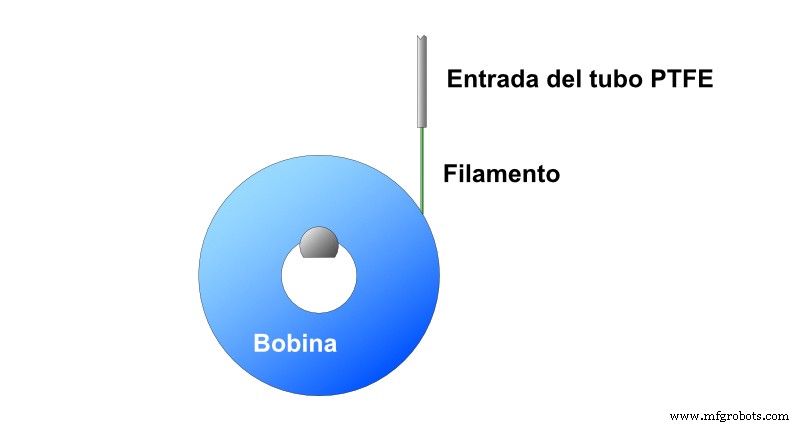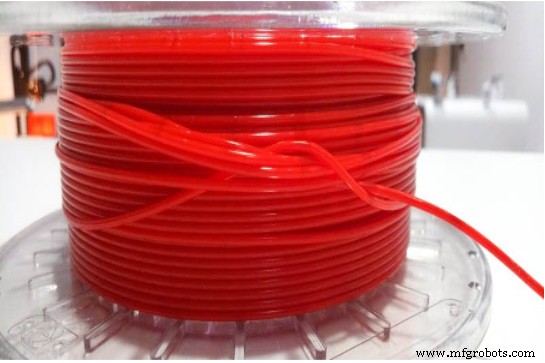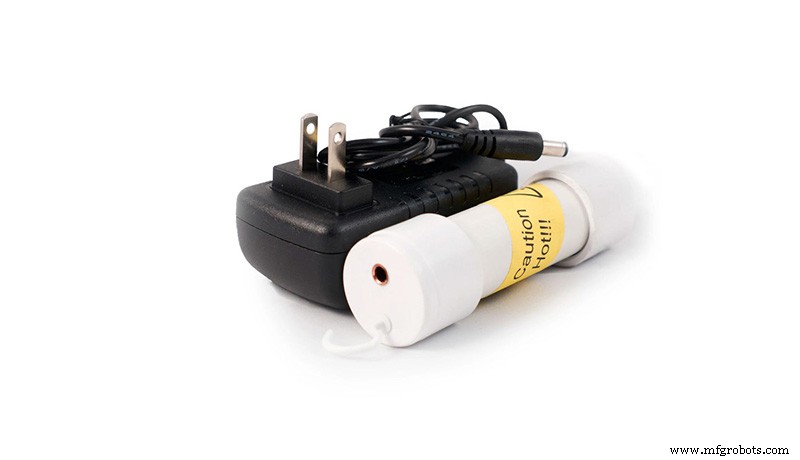Problemas debido a la colocación incorrecta de la bobina de filamento
Algo que a menudo no se considera, pero que puede ser una fuente de fallas, es la posición del carrete y su camino hacia la extrusora. Para facilitar el trabajo del extrusor,se debe buscar la mínima resistencia a la tracción del filamento . Cuanto mayor sea la resistencia, más duro tendrá que trabajar el motor del extrusor, generando más calor y aumentando la posibilidad de pérdida de paso. Además, aumentará la fricción de las ruedas con el filamento, provocando más desgaste y suciedad y aumentando la posibilidad de mordeduras en el filamento.
Posición óptima de la bobina
La ubicación óptima de la bobina es aquella que garantiza el camino más corto y recto hacia la extrusora. Además, se deben tener en cuenta los siguientes puntos:
- Tubos de PTFE: Si la distancia entre la bobina y el extrusor es alta (normalmente más de 15-20 cm) o si no es posible colocar la bobina directamente sobre el extrusor en sistemas directos, se debe utilizar un tubo de PTFE para guiar el filamento.
- Si se utiliza el tubo de PTFE para conducir el filamento desde el carrete hasta el extrusor, se debe utilizar un tubo con una sección transversal interna ligeramente mayor que el diámetro del filamento. Los tubos con diámetros reducidos producirán más fricción y aumentarán la tensión en el motor.
- Si se utiliza el tubo de PTFE para conducir el filamento desde el extrusor hasta el hotend (sistemas Bowden), el diámetro interno debe ajustarse para lograr la presión más homogénea posible. En estos casos se recomienda utilizar tubería de PTFE de alta calidad con el menor coeficiente de fricción posible.
En cualquier caso, el recorrido debe ser lo más corto posible (máximo 80 cm en el caso de los sistemas Bowden) y con el mayor radio de curvatura posible. Además, un extremo del tubo de PTFE debe insertarse directamente en la extrusora, mientras que el otro extremo debe colocarse tangente a la bobina y a una distancia de unos 10 cm del área de desenrollado del filamento.

Imagen 1:Posición correcta de la entrada del tubo de PTFE. Fuente Filament2print
- Soporte de bobina :Aunque pueda parecer que lo mejor es que el portabobinas ejerza la menor fricción posible, no es así. It is true that the bobbin holder should not exert excessive friction, but neither should it allow the bobbin to turn freely. If the spool rotates too much, it will cause a loss of tension in the last few turns of filament, increasing the risk of overlapping as tension is regained.

Image 2:Filament overlap in a coil. Source:Filament2print.com
Flexible Filaments
In the case of flexible filaments, it is particularly important to reduce the distance and friction. If there are considerable friction values, the filament will deform proportionally to the distance to the spool, reducing its cross-section due to the striction phenomenon. For practical purposes, this means that the real cross-section of the filament is not the nominal one, making it necessary to readjust the flux to avoid lack of extrusion. This is why it is sometimes necessary to use flow values above 115% in certain combinations of printer and flexible filament.
Filaments with metallic or ceramic fillers
One of the characteristics of the filaments with a high metallic or ceramic load intended for sintering is their high bending brittleness. This is why the way of feeding this type of filament is crucial to avoid breakage during printing.
Whenever you want to use this type of filament, it is advisable to do so in a 3D printer with a direct extrusion system and feed the filament in such a way that the path from the spool to the extruder is completely straight.
In the case of using Bowden printers, the largest possible bending radius in the path should be sought, even if this means using longer lengths of PTFE tubing. It may also be necessary to use devices that preheat the filament before it reaches the extruder in order to increase its ductility.

Image 3:Filawarmer device, intended for preheating metal filaments. Source:The Virtual Foundry
Note:This guide discusses concepts in a general way and does not focus on a particular brand or model, although they may be mentioned at some point. There may be important differences in calibration or adjustment procedures between different makes and models, so it is recommended that the manufacturer's manual be consulted before reading this guide.
Impresión 3d
- La guía para principiantes sobre la fabricación de filamentos fundidos (FFF)
- El triodo
- Los problemas más comunes del sistema de refrigeración del automóvil
- Sistemas de posicionamiento Wi-Fi en interiores:lo bueno, lo malo y las alternativas
- El pelaje vuela cuando surgen problemas
- Los mayores problemas de lubricación
- Parte de la semana:carrete extra y rejilla para herramientas de Tony Nutile
- La seguridad de ICS en el centro de atención debido a las tensiones con Irán
- Ender 3:¡Cómo limpiar la boquilla (Desatascarla)!
- Los problemas de generadores industriales más comunes
- Problemas con el sello de vidrio a metal en la electrónica



